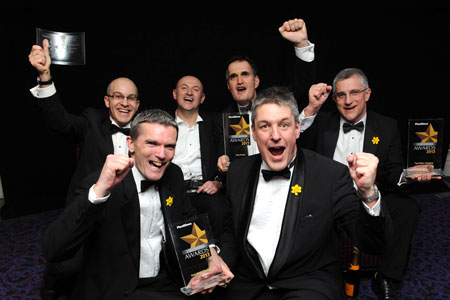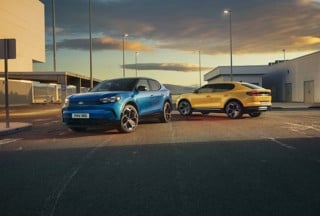His predecessor Kevin Griffin collected 22 Fleet News Awards trophies during nine years as fleet director.
Just four months into his tenure, Phil Hollins has already held aloft three trophies at the 2013 ceremony: small car of the year (Fiesta), green fleet manufacturer and most improved fleet manufacturer.
Although his return to the UK fleet operation is a recent development, Hollins has extensive knowledge and experience at Ford.
He worked for former fleet director Mike Wear in the late-1990s when helping to establish the Ford Direct approved used vehicle network.
He’s been with the company for 28 years, most recently as director, product marketing, Ford of Europe.
As fleet director, Hollins has big shoes to fill. Griffin, a member of the Fleet News Hall of Fame, was highly respected and well-known in the fleet sector.
He steered Ford through some tough times to strengthen its position in true fleet to such an extent that it is now the sector leader.
It’s Hollins’s responsibility to continue that growth trajectory in both the car and van markets.
Fleet News: Moving from product marketing director to UK fleet director could be seen, at best, as a sideways move. What attracted you to this role?
Phil Hollins: I spent 10 years at Ford of Europe; it’s important to stay in reality with the day-to-day market.
The operational nature of the job means you can get out of touch otherwise. There was also the geography: I was commuting to Germany but my family is here in the UK.
I did work in fleet before, in 1993 when Mike Wear was fleet director, so it’s an area I understand. This role is about two things: product and people. Get those right in fleet and you will be in a good place.
FN: So far this year the figures from SMMT show you are down in fleet year-on-year. Presumably this wasn’t part of the plan?
PH: The problems at Genk haven’t helped with supply: the order to delivery time for the Mondeo is still around three to four weeks on top of the usual 12 weeks.
Fleet should be more predictable than retail so we measure as much on our order bank as our sales figures.
We compare now and the next three months in each channel .
Over the next three months we are looking strong on net fleet orders but at the start of the year it wasn’t like that.
We had a hole in our forward orders so we missed our target for the first three months. It took that time to get the order bank strong enough to hit the numbers.
FN: How did you achieve that?
PH: We have accelerated our pre-launch activity. We tended to wait until we sold our current models before starting to sell the new one.
But we can actively sell them at the same time which gives us a faster ramp up in sales and a smoother launch. We will do this with the new Connect car.
We are also working with contract hire companies to get indicative pricing earlier so we can work out our terms for our target customers.
Then we have to target customers with our pre-sell presentation.
So we start the dialogue earlier and generate orders three to six months earlier than we would otherwise have done.
FN: Three products account for the bulk of Ford’s fleet car sales – Fiesta, Focus and Mondeo. Why?
PH: We are a volume brand. If someone is trying to hit their numbers then they pick the biggest levers and it’s worked . But as we try to improve our margins we have to grow in the more profitable channels with net fleet and our other cars.
FN: How do you see the opportunities with other models?
PH: We have a lot more products that can grow so the challenge is to leverage the C-Max, S-Max, Kuga and other models to be more credible in fleet.
The Kuga and S-Max are products where we can change the perspectives of the brand, especially in the user-chooser segment.
We have to talk to people about them – in some instances they do not know that we have an S-Max or B-Max – and have them available to test drive. Then it’s about looking at the business terms.
We have a great portfolio with a lot of new cars coming. We are also in great shape on powertrains.
FN: Car sales in fleet might have been off to a slow start this year, but commercial sales are very strong. What are your aspirations for both in 2013?
PH: Commercial vehicles have blown the doors off in the first quarter; they have performed strongly and our order bank is in great shape.
We also have new models this year and next.
We see our volumes and market share rising.
For cars, we see our share of true fleet rising in a flat market.
We will be down on rental by around 1,000, and down on demonstrators.
Growth will come from both multi-badge customers, where we have to get more of their business, and finding new customers.
We are expanding our field force to achieve this.
For dealers, it’s about winning new cust-omers in the small to medium market and we have a plan in place for this.
We have recently put a plan together to win more blue-light customers. We are giving our teams flexibility on support terms so they can get the business. We are also increasing our marketing to get product awareness up and getting out product in front of police.
FN: How do you see the true fleet sector changing over the next couple of years?
PH: We expect it to be fairly flat this year and for the next few years.
We are basing our performance objectives on that forecast. Net fleet is extremely competitive, especially with the mainland Europe pressures.
But managing our business on the four channels will improve residual values.
We aren’t going to do silly deals on rental at ridiculous money – it would make our job in the future harder if we chased the big deals.
FN: Any surprises since returning to the UK market?
PH: I’m amazed that there are opportunities to do more with everyone we speak to. I can see a lot of upsides, even though we are the market leader. That’s down to the strength of our relationships with fleets – that can’t be under-estimated.
Hollins takes a highly methodical approach to managing his business.
Surrounded by spreadsheets, he has all the data at his fingertips. He knows where every unit is going and from where every order is coming.
It’s this approach that is helping him to, as he puts it, “plug gaps” in the order book, strengthening the longer term forecast for the business by identifying issues before they become problems.
There’s speculation that Hollins is being groomed for the UK managing director’s position when current incumbent Mark Ovenden continues his rise up through the Ford hierarchy.
Of course, it’s not something the 51-year-old wishes to comment on, and there are others equally suited to taking the top job, not least his predecessor Kevin Griffin.
But that’s for the future. His immediate priority is to return Ford’s 2013 fleet sales to growth. “We have the right products and we have the right people,” he says.
“We are as strong now as we have ever been and, if I look forwards, both cars and LCVs will go from strength to strength.”
Factfile
Company Ford
Fleet director Phil Hollins
2012 sales 281,917
2012 market share 13.79%
2012 fleet sales 157,269
2012 fleet share 15.34%
(May 16, 2013)






















Login to comment
Comments
No comments have been made yet.